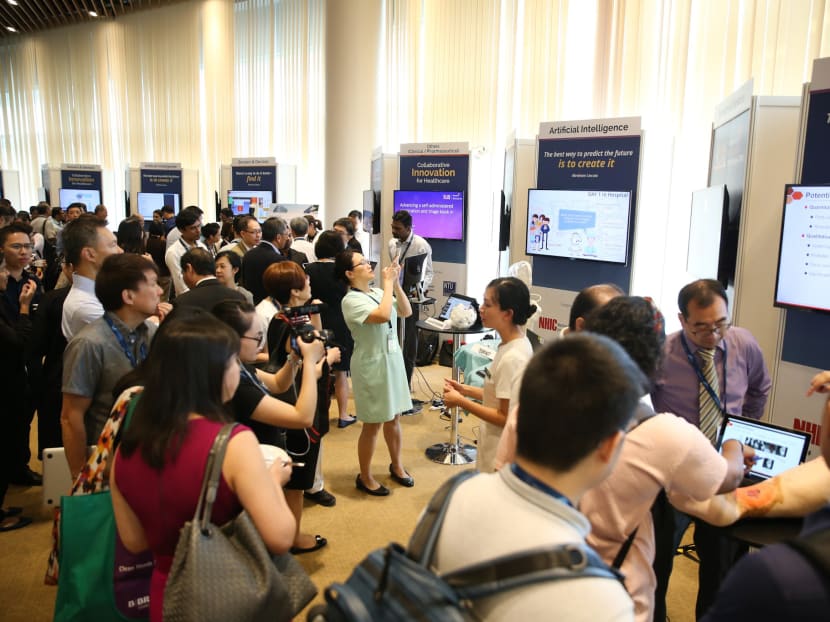Chatbots to assess patients’ conditions among key initiatives to digitise healthcare sector
SINGAPORE — Unsure if your chest pain is due to heart burn or if it could be a heart attack? You can soon ask a chatbot and get a quick response. In future, patients could get preliminary assessments on their medical conditions from a chatbot, which can also help make follow-up doctors’ appointments and reduce waiting times at hospitals and clinics.

Guests viewing the National HealthTech Challenge booths where new concepts and prototypes for HealthTech innovations are displayed at the National Health IT Summit (NHITS) 2018.
SINGAPORE — Unsure if your chest pain is due to heart burn or if it could be a heart attack? You can soon ask a chatbot and get a quick response.
In future, patients could get preliminary assessments on their medical conditions from a chatbot, which can also help make follow-up doctors’ appointments and reduce waiting times at hospitals and clinics.
The Health Ministry’s IT arm, Integrated Health Information Systems (IHiS), is working with chatbot technology providers to improve the efficiency and delivery of healthcare. It is one of the initiatives unveiled at the National Health IT Summit on Tuesday (July 17).
Prototypes of such chatbots could be tested across different healthcare sectors from as early as next year, said Director of the Emerging Services and Capabilities Group in IHiS Chua Chee Yong,
With chatbots, patients can also be directed to relevant clinics and doctors, and thereby saving them time waiting at hospitals. They can also have more productive consultation sessions with doctors as information about the patient would have already been obtained by the bot beforehand.
To kick start the chatbot initiative, the IHiS invited local and global startups as well as established companies to submit proposals with the aim of consolidating a panel of reliable companies that can be accredited to provide the artificial intelligence (AI) service.
To get the most out of chatbots, the solution providers may by curated based on their ability to localize their chatbots. For example, if the chatbots can learn Singapore’s heathcare schemes like Medisave and understand Singlish.
The exercise began in June and ended last Friday (July 13). The IHiS is currently consolidating and evaluating the proposals.
The list of accredited chatbot providers will be made available by the end of the year and public healthcare institutions will be able to tap on this list if they wish to introduce them in their institutions.
Singapore will not be the first country where healthcare providers use chatbots. In London, for example, patients can describe their symptoms, see a General Practitioner through video consultation and book appointments via a smartphone app called Babylon Health, which is powered by AI.
Other initiatives unveiled at the National Health IT Summit, organised by IHis, include creating a collaborative “match-making” platform for healthcare providers and private technology companies through an annual National HealthTech challenge, and developing a Robotics Middleware Framework for Healthcare.
With the National HealthTech challenge, healthcare providers can pose “problem statements” based on issues they face, and be matched with technology providers — such as data analytics companies among others — that can help with solutions.
The winning teams would have access to funding from supporting agencies, which include GovTech Singapore, Enterprise Singapore and the Ministry of Health.
At this year’s inaugural National HealthTech challenge, among the 20 project finalists is a collaboration between the Singapore General Hospital and tech company Mages Studio, which aims to beat patient anxiety before surgery.
Using immersive virtual reality in a pre-and post-operation ritual, the patient’s questions and worries will be addressed and they will be brought through a three to five-minute guided meditation process.
In an effort to promote the use of consumer technology in healthcare, Healthcare Minister Gan Kim Yong stressed the need to involve private sector players.
Speaking at the summit, Mr Gan said: “We ought to think how we can apply technology and innovate at the systems level, beyond individual institutions. Robotics is one area where we are beginning to do this.”
To enable cross-sector collaboration, Singapore will develop its first Robotics Middleware Framework for Healthcare. The framework, which essentially works like a software system in the back-end, will enable different technology systems within and outside of healthcare to “talk” and work with each other.
This will in turn “create more opportunities for innovation”, “cross-sector collaborations” and bring technology solutions closer to citizens.
The Robotics Middleware Framework is a three-year research effort led by the Centre for Healthcare Assistive and Robotics Technology and IHis, involving government and industry partners. More details on the framework will be released later.
Mr Gan said: “The technology promises for healthcare are exciting. But we must remember not to adopt technology just for the sake of it. It must always be for the purpose of helping our citizens achieve better health outcomes.”






